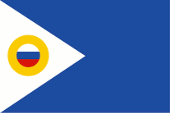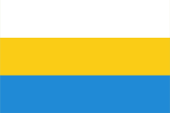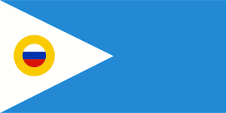Tschukotka
|
|
|
|
| Übersicht – Contents: | |
Diese Seite ist Teil des Projektes
Tschukotka
|
|
|
|
| Übersicht – Contents: | |
Flagge – Flag: |
|
 |
seit/since 1997, |
historische Flaggen – historical Flags: |
|
 |
1921–1922, |
 |
1994–1997, |
Bedeutung/Ursprung der Flagge – Meaning/Origin of the Flag: |
|
| Die Flagge von Tchukotka wurde am 28.02.1994 eingeführt. Es war ein einfarbig hellblaues Tuch, im Seitenverhältnis 1:2, mit einem weißen, bis zur Mitte der Flagge reichendem, gleichschenkligen Dreieck am Mast. Im Inneren des Dreiecks eine golden umrandete Scheibe mit den Farben Russlands. Am 29.10.2007 wurde die Flagge abgeändert. Das Seitenverhältnis wurde von 1:2 auf 2:3 umgestellt und das Blau von Hellblau auf Dunkelblau abgeändert. Blau ist die Nationalfarbe der Tschuktschen. Es steht aber auch für die Flüsse des Landes. Das Weiß steht für das Eis und den Schnee, der das Land die meiste Zeit des Jahres bedeckt. Das Gelb steht für Sonne, Hoffnung und Freundschaft. Im russischen Bürgerkrieg von 1917 bis 1922 hatten antibolschewistische Kräfte 1921 den Freistaat Tschukotka gegründet und versuchten von hier aus einige Zeit lang Widerstand gegen die Errichtung der Sowjetdiktatur zu leisten. Die Flagge des Landes zeigte drei waagerechte Streifen in Weiß, Gold und Hellblau. Die Farben dieser Flagge lassen sich in der heutigen Flagge wiederfinden, ob nun gewollt oder ungewollt. |
The flag of Chukotka was
introduced on 28th of February in 1994. It was a plain light blue bunting,
with an aspect ratio of 1:2, with a white isosceles triangle on the mast
that reached to the middle of the flag. Inside the triangle there is a
golden bordered disc with the colors of Russia. On 29th of October in 2007
the flag was changed. The aspect ratio was changed from 1:2 to 2:3 and the
blue was changed from light blue to dark blue. Blue is the national colour
of the Chukchi people. But it also stands for the country's rivers. The
white represents the ice and snow that covers the land most of the year. The
colour yellow represents sun, hope and friendship. During the Russian Civil War from 1917 to 1922, anti-Bolshevik forces founded the Chukotka Free State in 1921 and from here they tried for some time to resist the establishment of the Soviet dictatorship. The country's flag featured three horizontal stripes of white, gold and light blue. The colors of this flag can be found in today's flag, whether intentionally or unintentionally. |
| Quelle/Source: Wikipedia (EN), Wikipedia (RU), Volker Preuß | |
Wappen – Coat of Arms: |
|
 |
Wappen Tschukotkas – coat of arms of Chukotka, Quelle/Source: Russiatrek |
Bedeutung/Ursprung des Wappens – Meaning/Origin of the Coat of Arms: |
|
| Das Wappen von Tschukotka zeigt einen purpurfarbenen Schild. Darauf, auf einer hellblauen Scheibe, eine goldene Landkarte des Landes (ein Hinweis auf die Bodenschätze) mit einem Eisbären (ein Hinweis auf die Fauna). Ein roter achteckiger Stern markiert auf der Landkarte die Position der Hauptstadt Anadyr. | The coat
of arms of Chukotka shows a crimson shield. On it, on a pale blue disk, a
golden map of the country (a hint to the mineral resources) with a polar
bear (a hint to the fauna). A red eighth-pointed star marks on the map the
position of the capital Anadyr. |
| Quelle/Source: Volker Preuß | |
Landkarten – Maps: |
geographische Lage in Russland – geographical position within Russia: |
Landkarte des Landes – map of the country: |
Zahlen und Fakten – Numbers and Facts: |
|
|
|
|
|
|
|
|
|
|
|
|
|
|
|
|
|
|
|
|
|
|
Geschichte: |
|
17. Jahrhundert
· Beginn der russischen Erschließung im Süden des Landes 1649 · Gründung der Stadt Anadyrsk (heute Markowo) am Fluss Anadyr 1761/1762 · russische Erschließung des gesamten Landes, Versuche die Tschuktschen in Abhängigkeit zu zwingen oder eine Pelzsteuer einzuführen scheitern 1921–1922 · Freistaat Tschukotka 1923 · Errichtung der Sowjetdiktatur 10.12.1930 · Errichtung des "Autonomen Kreises der Tschuktschen" 1931 · Einführung der Tschuktschischen Schriftsprache mit kyrillischem Alphabet 1940–1990 · starke russische und ukrainische Zuwanderung 31.12.1991 · die Sowjetunion löst sich auf, die Verfassung der Russischen Sozialistischen Föderativen Sowjetrepublik (RSFSR, Russland), ein ehemaliger Teilstaat der Sowjetunion bleibt vorerst in Kraft 25.12.1993 · eine neue Verfassung für Russland (Russische Föderation) tritt in Kraft, das Verhältnis zu den Gliedern der Föderation wird damit neu geregelt seit 1995 · durch den Rückgang des Bergbaus starke Abwanderung der Bevölkerung (60% bis 2008) |
History: |
|
17th century
· start of the Russian exploitation in the south of the country 1649 · foundation of Anadyrsk Town (today Markovo) at the Anadyr River 1761/1762 · Russian exploitation of the whole country, attempts to force the Chukch in dependence or to introduce a fur tax fail 1921–1922 · Free State of Chukotka 1923 · establishment of the soviet dictatorship 10th of December 1930 · establishment of the "Autonomous District of the Chukchee" 1931 · introduction of the Chukchee writing diction with cyrillic alphabet 1940–1990 · potent Russian and Ukrainian immigration 31st of December in 1991 · the Soviet Union dissolves, the constitution of the Russian Socialist Federative Soviet Republic (RSFSR, Russia), a former substate of the Soviet Union, remains in force for the time being 25th of December in 1993 · a new constitution for Russia (Russian Federation) comes into force, and the relationships with the members of the federation is re-regulated in this way since 1995 · because of the decline of mining potent migration of the population (60% until 2008) |
| Quelle/Source: Atlas zur Geschichte, World Statesmen, Russiatrek, Die Völker der Erde, Wikipedia (D) |
Ursprung des Landesnamens – Origin of the Country's Name: |
|
| Der Name Tschukotka heißt "Land der Tschuktschen". Sich selbst nennen die Tschuktschen jedoch "Tschautschu Lygorawetljan", was "wahrer Mensch" bedeutet. | The name
Chukotka means "Land of the Chukch". But the Chukch call themselves "Chauchu
Lygorawetlyan", what means "true human being". |
| Quelle/Source: Die Völker der Erde | |